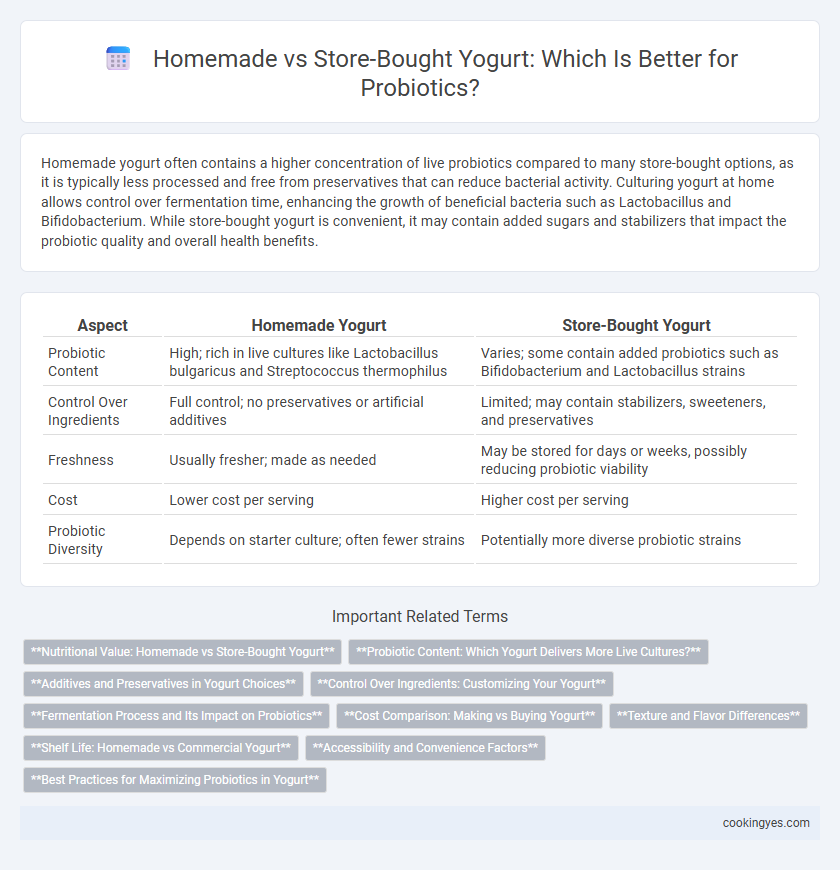Homemade yogurt often contains a higher concentration of live probiotics compared to many store-bought options, as it is typically less processed and free from preservatives that can reduce bacterial activity. Culturing yogurt at home allows control over fermentation time, enhancing the growth of beneficial bacteria such as Lactobacillus and Bifidobacterium. While store-bought yogurt is convenient, it may contain added sugars and stabilizers that impact the probiotic quality and overall health benefits.
Table of Comparison
| Aspect | Homemade Yogurt | Store-Bought Yogurt |
|---|---|---|
| Probiotic Content | High; rich in live cultures like Lactobacillus bulgaricus and Streptococcus thermophilus | Varies; some contain added probiotics such as Bifidobacterium and Lactobacillus strains |
| Control Over Ingredients | Full control; no preservatives or artificial additives | Limited; may contain stabilizers, sweeteners, and preservatives |
| Freshness | Usually fresher; made as needed | May be stored for days or weeks, possibly reducing probiotic viability |
| Cost | Lower cost per serving | Higher cost per serving |
| Probiotic Diversity | Depends on starter culture; often fewer strains | Potentially more diverse probiotic strains |
Nutritional Value: Homemade vs Store-Bought Yogurt
Homemade yogurt often contains higher probiotic diversity and live cultures compared to many store-bought varieties, which may undergo pasteurization that reduces beneficial bacteria. Nutritional value in homemade yogurt can be enhanced by controlling fat content and avoiding additives, resulting in a product rich in protein, calcium, and essential nutrients. Store-bought yogurts frequently include added sugars and stabilizers, potentially diminishing their overall health benefits despite convenience and consistency.
Probiotic Content: Which Yogurt Delivers More Live Cultures?
Homemade yogurt typically contains a higher concentration of live probiotic cultures compared to many store-bought varieties, as it is freshly fermented and free from heat treatments that can reduce bacterial viability. Store-bought yogurts often undergo pasteurization after fermentation, which can significantly decrease the number of live beneficial bacteria, although some brands add probiotics post-pasteurization to compensate. For maximizing probiotic intake, selecting homemade yogurt or store-bought products labeled with "live and active cultures" and specific strains like Lactobacillus acidophilus or Bifidobacterium bifidum ensures greater delivery of viable microbes.
Additives and Preservatives in Yogurt Choices
Homemade yogurt typically contains no additives or preservatives, ensuring a natural probiotic profile that supports gut health more effectively than many store-bought options. Commercial yogurts often include stabilizers, sweeteners, and artificial preservatives that can reduce the viability of beneficial bacteria and introduce unwanted chemicals. Choosing homemade yogurt allows for full control over ingredients, maximizing probiotic potency and minimizing exposure to synthetic additives.
Control Over Ingredients: Customizing Your Yogurt
Homemade yogurt offers unparalleled control over ingredients, allowing you to choose high-quality milk and precise probiotic strains tailored to your health needs. Unlike many store-bought yogurts that contain added sugars, preservatives, and artificial thickeners, making yogurt at home ensures a purer, cleaner product. This customization enhances probiotic potency and supports better digestive health outcomes.
Fermentation Process and Its Impact on Probiotics
Homemade yogurt undergoes a natural fermentation process where live bacterial cultures such as Lactobacillus bulgaricus and Streptococcus thermophilus proliferate, resulting in a higher concentration of active probiotics compared to many store-bought yogurts that may contain heat-treated or reduced live cultures. This extended fermentation allows beneficial bacteria to multiply and produce lactic acid and bioactive compounds, enhancing gut health through improved microbiota diversity. In contrast, commercial yogurts often have controlled fermentation times and additives that can diminish probiotic viability and efficacy.
Cost Comparison: Making vs Buying Yogurt
Making homemade yogurt significantly reduces costs compared to purchasing store-bought yogurt, with ingredients like milk and starter cultures priced far lower per serving. Store-bought probiotic yogurts often carry premium prices due to branding, packaging, and added probiotic strains. Over time, homemade yogurt proves more economical while allowing control over probiotic content and ingredient quality.
Texture and Flavor Differences
Homemade yogurt exhibits a creamier texture and more pronounced tangy flavor due to the active live cultures and absence of stabilizers found in many store-bought varieties. Store-bought yogurt often contains additives and thickeners that create a consistent texture but can dilute the natural probiotic profile and alter flavor complexity. The natural fermentation in homemade yogurt enhances probiotic diversity, contributing to richer taste and improved gut health benefits.
Shelf Life: Homemade vs Commercial Yogurt
Homemade yogurt typically has a shorter shelf life of about 1 to 2 weeks due to the absence of preservatives and the use of live cultures that continue to ferment, which can alter taste and texture over time. Commercial yogurt often contains stabilizers and preservatives, extending its shelf life to 3 to 4 weeks while maintaining consistent probiotic viability. Proper refrigeration is essential for both types to preserve probiotic benefits and prevent spoilage.
Accessibility and Convenience Factors
Homemade yogurt offers cost-effective probiotic benefits with control over ingredients, but requires time, specific equipment, and a consistent fermentation process, limiting accessibility for some. Store-bought yogurt provides instant access to a variety of probiotic strains, convenient packaging, and standardized quality, making it a practical option for busy lifestyles. Both options deliver beneficial probiotics, yet convenience and accessibility remain key factors influencing consumer choice.
Best Practices for Maximizing Probiotics in Yogurt
Maximizing probiotics in yogurt involves using high-quality, live active cultures such as Lactobacillus bulgaricus and Streptococcus thermophilus, which are essential for gut health. Homemade yogurt allows control over fermentation time and temperature, typically between 100degF to 110degF for 6-12 hours, promoting optimal bacterial growth and higher probiotic concentration. Using fresh, whole milk and avoiding overheating during incubation preserves probiotic viability better than many store-bought options, which can lose potency due to pasteurization and extended shelf life.
Homemade yogurt vs store-bought yogurt for probiotics Infographic

 cookingyes.com
cookingyes.com